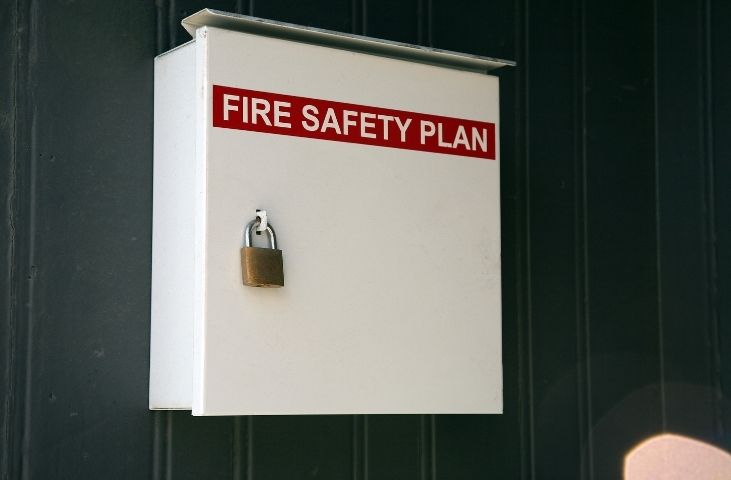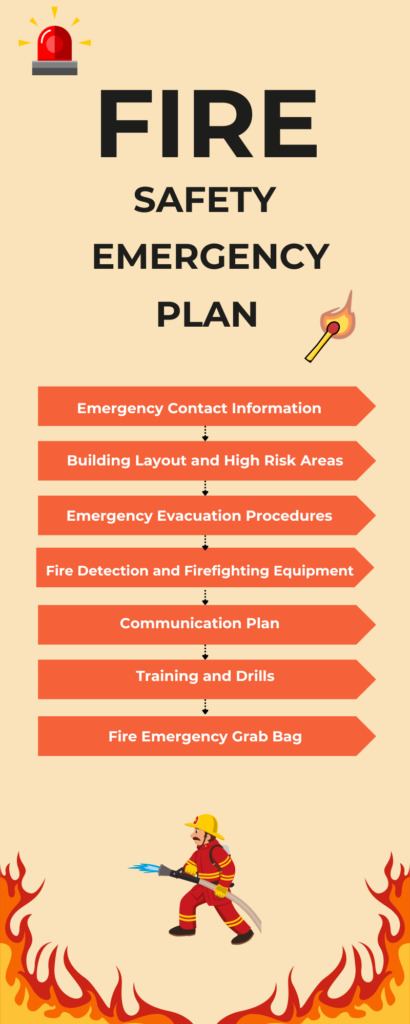Fire Safety Emergency Plan

Estimated reading time: 4 minutes
Fire Safety Emergency Plan
A Fire Safety Emergency Plan outlines what information you need to know in the event of a fire. Its primary objective is to protect individuals and property by ensuring that everyone understands their roles and actions during a fire emergency.
This blog highlights the components of an effective Fire Safety Emergency Plan. At the end of the blog you will find a downloadable template that allows you to create and complete your own Fire Safety Emergency Plan tailored to your building’s specific needs.
Key Elements of a Fire Safety Emergency Plan

1. Emergency Contact Information
The emergency contact information section provides contact details of staff responsible for fire safety, including phone numbers for local fire stations. This includes the details of the Incident Controller who manages the fire emergency response and is normally a trained fire warden or the building manager.
2. Building Layout and High-Risk Areas
This area of the Fire Safety Emergency Plan details the building’s structure and physical layout and identifies areas with heightened fire risks, such as kitchens and fire safety features such as exits, alarm call points, fire equipment locations and assembly areas.
3. Emergency Evacuation Procedures
A fundamental aspect of the Fire Safety Emergency Plan is the evacuation procedures. This section should include information such as:
- Communication method for evacuation such as fire alarms.
- Diagrams of primary and secondary escape routes.
- Personal Emergency Evacuation Plans (PEEPs) for individuals requiring extra assistance.
- Instructions for high-risk fire hazard zones.
- Information on responsible people who will do specific fire safety duties such as roll calls, contact the emergency services and be responsible for clear all areas.
- The location of designated assembly points for everybody who has been evacuated.
4. Fire Detection and Firefighting Equipment
The Fire Safety Emergency Plan should document the locations of fire detection systems, including alarms, smoke detectors and sprinklers as well as providing clear instructions for using these systems, if required. Additionally, the plan should specify the locations and types of firefighting equipment, such as extinguishers. Regular inspection and maintenance schedules for this equipment should also be recorded, documenting the results.
5. Communication Plans
An effective Fire Safety Emergency Plan must incorporate a communication strategy to keep everyone informed during a fire. This plan should detail how employees, visitors and emergency services will be notified.
6. Training and Drills
Regular training and drills are essential part of the Fire Safety Emergency Plan and include details such as the frequency of drills and the individuals responsible for organising them. Additionally, the plan should address the frequency and details of fire safety training sessions for staff.
7. Fire Emergency Grab Bag
A fire emergency grab bag is designed for immediate access during a fire or other emergencies. This bag should contain essential items to meet immediate needs during an evacuation. You can find out more about Fire Emergency Grab Bags in our article: Emergency Grab Bags: What are they?
By putting together and regularly updating and reviewing a Fire Safety Emergency Plan, organisations can effectively protect their employees, visitors and property in the event of a fire.
You can download a version of a Fire Safety Emergency Plan template in the Related Links section to complete for your organisation, ensuring you have a thorough plan in place.
Our accredited online Fire Marshal/Warden Course for staff or face-to-face Fire Marshal/Warden Courses, will look at some of the essential components of a fire safety emergency plan, such as evacuation plans and the use of firefighting equipment. By understanding these components, learners will be better prepared to implement the Fire Safety Emergency Plan.
Alternatively, if you would like additional information about your fire training requirements, you can get in touch with our friendly customer service team by calling us on 01327 552160, emailing us at hello@smarthorizons.co.uk, getting in touch via live chat or filling in our web contact form.
